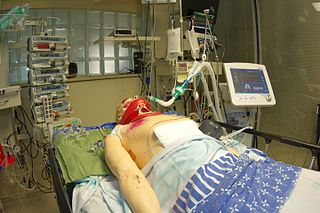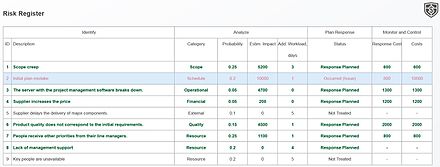A simulation is an approximate imitation of the operation of a process or system; that represents its operation over time.
A simulation video game describes a diverse super-category of video games, generally designed to closely simulate real world activities.

Application software is a program or group of programs designed for end users. Examples of an application include a word processor, a spreadsheet, an accounting application, a web browser, an email client, a media player, a file viewer, an aeronautical flight simulator, a console game or a photo editor. The collective noun application software refers to all applications collectively. This contrasts with system software, which is mainly involved with running the computer.
A train simulator is a computer based simulation of rail transport operations. They are generally large complicated software packages modeling a 3D virtual reality world implemented both as commercial trainers, and consumer computer game software with 'play modes' which lets the user interact by stepping inside the virtual world. Because of the near view modeling, often at speed, train simulator software is generally far more complicated and difficult software to write and implement than flight simulator programs.
A responsibility assignment matrix (RAM), also known as RACI matrix or linear responsibility chart (LRC), describes the participation by various roles in completing tasks or deliverables for a project or business process. RACI is an acronym derived from the four key responsibilities most typically used: Responsible, Accountable, Consulted, and Informed. It is used for clarifying and defining roles and responsibilities in cross-functional or departmental projects and processes. There are a number of alternatives to the RACI model.
Roleplay simulation is an experiential learning method in which either amateur or professional roleplayers improvise with learners as part of a simulated scenario. Roleplay is designed primarily to build first-person experience in a safe and supportive environment. Roleplay is widely acknowledged as a powerful technique across multiple avenues of training and education.
Project Portfolio Management (PPM) is the centralized management of the processes, methods, and technologies used by project managers and project management offices (PMOs) to analyze and collectively manage current or proposed projects based on numerous key characteristics. The objectives of PPM are to determine the optimal resource mix for delivery and to schedule activities to best achieve an organization’s operational and financial goals, while honouring constraints imposed by customers, strategic objectives, or external real-world factors. The International standard defines the framework of the Project Portfolio Management
Business simulation is simulation used for business training, education or analysis. It can be scenario-based or numeric-based.

SIMUL - i.e. Système Intégré de Modélisation mULti-dimensionelle - is an econometric tool for the multidimensional modelling. It allows to implement easily multidimensional econometric models according to their reduced form - where X and Y are two economic variables, r and b (resp.) denote the region and the branch (resp.) and where is the residual.
Microsoft Train Simulator 2 was a train simulation game in development by Microsoft Game Studios on two occasions. Meant to be the successor to Microsoft Train Simulator, it was originally announced in 2003, until being cancelled in 2004. The second attempt at the game was first announced on January 19, 2007, and originally scheduled for release in the last quarter of 2009. It was postponed indefinitely and virtually cancelled due to the closure of Aces Game Studio in 2009.
Project management simulation is simulation used for project management training and analysis. Project management simulation is often used as training simulation for project managers. In other cases it is used for what-if analysis and for supporting decision-making in real projects. Frequently the simulation is conducted using software tools.

Medical simulation, or more broadly, healthcare simulation, is a branch of simulation related to education and training in medical fields of various industries. Simulations can be held in the classroom, in situational environments, or in spaces built specifically for simulation practice. It can involve simulated human patients - artificial, human or a combination of the two, educational documents with detailed simulated animations, casualty assessment in homeland security and military situations, emergency response, and support virtual health functions with holographic simulation. In the past, its main purpose was to train medical professionals to reduce error during surgery, prescription, crisis interventions, and general practice. Combined with methods in debriefing, it is now also used to train students in anatomy, physiology, and communication during their schooling.
Human-in-the-loop or HITL is defined as a model that requires human interaction. HITL is associated with modeling and simulation (M&S) in the live, virtual, and constructive taxonomy. HITL models may conform to human factors requirements as in the case of a mockup. In this type of simulation a human is always part of the simulation and consequently influences the outcome in such a way that is difficult if not impossible to reproduce exactly. HITL also readily allows for the identification of problems and requirements that may not be easily identified by other means of simulation.
The ADMS is an emergency and disaster management training simulation system designed to train incident commanders, first responders, and incident command teams in a real-time, interactive virtual reality environment. ADMS was first introduced by Environmental Tectonics Corporation (ETCC:US) in 1992. The development of ADMS was in response to the crash of British Airtours Flight 28M at the Manchester airport in 1985, in which 55 people died. Following the accident research indicated that first responder training should include realistic scenarios. The first ADMS system was produced for the UK Ministry of Defence, and delivered to Royal Air Force's (RAF) Manston Facility. Since its inception, ADMS has evolved into a modular, expandable disaster simulation platform, with systems in use worldwide.
In business, training simulation is a virtual medium through which various types of skills can be acquired. Training simulations can be used in a variety of genres; however they are most commonly used in corporate situations to improve business awareness and management skills. They are also common in academic environments as an integrated part of a business or management course.
Markstrat is a simulation game, created by Jean-Claude Larréché, that lets the players take control of a virtual corporation; making decisions on its behalf. Jean-Claude Larréché and Professor Hubert Gatignon developed the simulation from 1974 to 1977. After the game was developed it was distributed on an ad-hoc basis by INSEAD. The game is widely known, and played in over 500 academic institutions, including 8 of the top 10 international business schools and 25 of the top 30 in the US. The players of the simulation have to make number of decisions, in marketing, finance, research and development areas, in order to achieve a better performance than the competing players who also take control of a company.
Project team builder is a project management simulation tool developed for training and teaching the concepts of project management and for improving project decision making. A number of published books and academic papers are based on the PTB and its predecessors. The PTB won the Project Management Institute Professional Development Product of the Year Award. The PTB is used in universities and business organizations around the world. The simulator is based on an approach that separates the simulation engine from the scenario editor and allows each user to simulate any project. The simulation engine simulates the dynamic stochastic nature of modern projects. The design of the PTB supports the system engineering approach to Problem solving as each scenario presents the requirements, the alternatives that can be selected and the constraints imposed on the solution. The user has to trade off the cost, schedule, risk, and benefits to the stake holders and to find a feasible, robust, good solution for the scenario. The solution is then simulated by the simulation engine while the trainee exercises monitoring and control throughout the execution. A planned project can be simulated using Monte Carlo simulation. This is done in automatic mode and shows the probability to finish the project at any time period or at any cost. Furthermore, based on the Monte Carlo simulation the probability of each activity to be on the critical path is estimated. The Monte Carlo analysis supports risk analysis and decision making. Another characteristic of the simulator is the ability to save points in the history of each run for future analysis or even for testing a different solution from any of the points saved.
Cruden B.V. is a Dutch motion-based racing simulator designing and manufacturing company based in Amsterdam. Founders of Cruden have been developing professional motion simulators since the 1990s. Their expertise on designing simulators for aerospace industry leads them to transfer this knowledge to marine, automotive and motorsport industry. Simulator of Cruden is branded as Hexatech.
A surgery simulator is computer technology developed to simulate surgical procedures for the purpose of training medical professionals, without the need of a patient, cadaver or animal. The concept goes back to the 1980s with video games, but only in the 1990s with three-dimensional graphics and the 2000s with the use of motion sensors for realistic movements has the technology been able to simulate the real situation. The most common type of surgery taught through this method is laparoscopic surgery, although it has also been used to do a trial run before other kinds of procedures.

MSR - The Israel Center for Medical Simulation is Israel's national institute for Simulation-Based Medical Education (SBME) and Patient Safety training. It is located at the Chaim Sheba Medical Center in the Tel HaShomer neighborhood of Ramat Gan, in the Tel Aviv District. MSR is internationally recognized as leader in patient safety simulation-based training.











